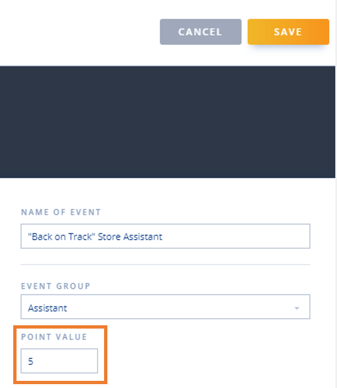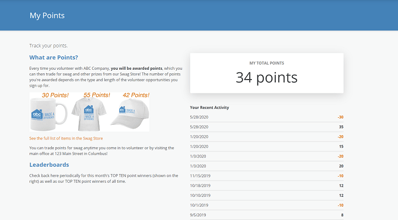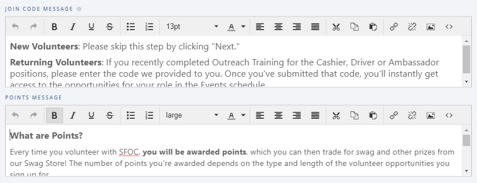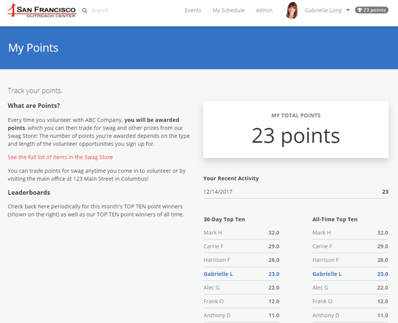VolunteerHub provides the software that nonprofits need to effectively recruit, engage, and manage volunteers. Request a demo today, and learn how VolunteerHub can streamline your organization’s volunteer program.


For those who don’t know, gamification is the application of game principles and rewards into non-game contexts. Incorporating gamification within a volunteer program can help an organization retain and engage valuable supporters. As the value of a volunteer hour continues to rise ($31.80 in 2023), the importance of volunteer engagement and retention also increases. Gamification provides an organization with a differentiator and volunteers with a motive to continue to give regularly.
Many studies have demonstrated the value of gamification in both the for-profit and nonprofit sectors. In fact, 87% of people surveyed agree that gamification makes them more productive. For nonprofit organizations, gamification offers the unique opportunity to entice volunteers, reward them, and create long-term ambassadors for a cause.
Here are 3 ways nonprofit organizations can use gamification to strategically increase volunteer engagement, and drive program efficiency.
Creating a rewards program is a great way to enhance volunteer-based initiatives. Because volunteers are not being paid for their valuable time, organizations can use points and perks to stand out and provide volunteer constituents with value. The accumulation of points and the ability to exchange points for prizes, such as organizational merchandise, increases volunteer engagement and provides a nonprofit with a way of marketing their unique cause/brand. Many organizations use branded prizes (example: t-shirts) to launch grassroots marketing campaigns within the community.
Some volunteer management solution providers, such as VolunteerHub, understand the importance of gamification and incorporate it into their software. In VolunteerHub, administrators can add a point value to each of their volunteer opportunities in order to drive engagement and differentiate critical roles.
Below is what the points-based gamification feature in VolunteerHub looks like from both the admin and volunteer views.

Admin View – VolunteerHub

Volunteer View – VolunteerHub
One example of an organization using gamification to create value for volunteers is Open Hand Atlanta. Open Hand Atalanta uses a point system (LeaderTree program) to provide volunteers with prizes in exchange for their time. To date, Open Hand Atlanta has saved over $649,000 since initiating its gamification-based rewards program.
Deploying gamification can help nonprofits reward volunteers who go above and beyond. This is especially true with a point-based gamification strategy. Many organizations reward extra points to volunteer constituents who exceed expectations, refer talent, or provide testimonials. Depending on an organization’s mission, a reward system can be created that outlines what going above and beyond means, and how volunteers will be rewarded for extra achievements.
It is key that organizations reward top-performing volunteers if they want to retain them. On average, volunteers provide 50 hours of service to an organization each year. Nonprofits that provide high-performance volunteers with incentives to give have a better chance of tapping into their full value. Reward and recognition strategies that provide “bonus points” for over achievement can help an organization maintain its top talent and incentivize them.
Using VolunteerHub’s gamification features, organizations can provide high-performing volunteers with additional points to use towards their reward and recognition program.
Effective communication is one of the most important components of gamification and engaging volunteers strategically. For organizations that deploy a rewards and recognition strategy, communicating the program is almost as important as creating it. Nonprofits can use gamification to create engaging call-to-actions as part of their communication process with both current volunteers and prospects. Because the nonprofit space is competitive, organizations should use rewards and recognition as a way to stand out, and drive new volunteer relationships.
Investing and deploying a volunteer management system can help organizations communicate with volunteers and provide information about their rewards program. With VolunteerHub, administrators are easily able to communicate their program to both groups and individual volunteers, quickly and efficiently.
The screenshot below shows how easy it is to communicate a rewards program with volunteers within the VolunteerHub system.

Rewards and Recognition Communication – VolunteerHub
Using gamification to create a strategic reward and recognition program also gives organizations content to promote. For example, many organizations are using VolunteerHub to display a leader board to volunteers, based on the accumulation of points for a specific period of time.
The leaderboard can be promoted as part of an organization’s communication strategy.
Below is a screenshot of the leaderboard functionality in VolunteerHub.

Points-Based Reward Program Leaderboard – VolunteerHub
Gamification can provide organizations with a new way to engage volunteers, provide rewards and recognition, and improve retention. Setting up and deploying a rewards program, backed by gamification, is easier than many nonprofits think. Investing in the right tools, with the right features, can help a nonprofit take its volunteer program to new heights.
VolunteerHub provides the software that nonprofits need to effectively recruit, engage, and manage volunteers. Request a demo today, and learn how VolunteerHub can streamline your organization’s volunteer program.
Subscribe to receive email notifications every time we publish new insights, news, and thought leadership to our blog.